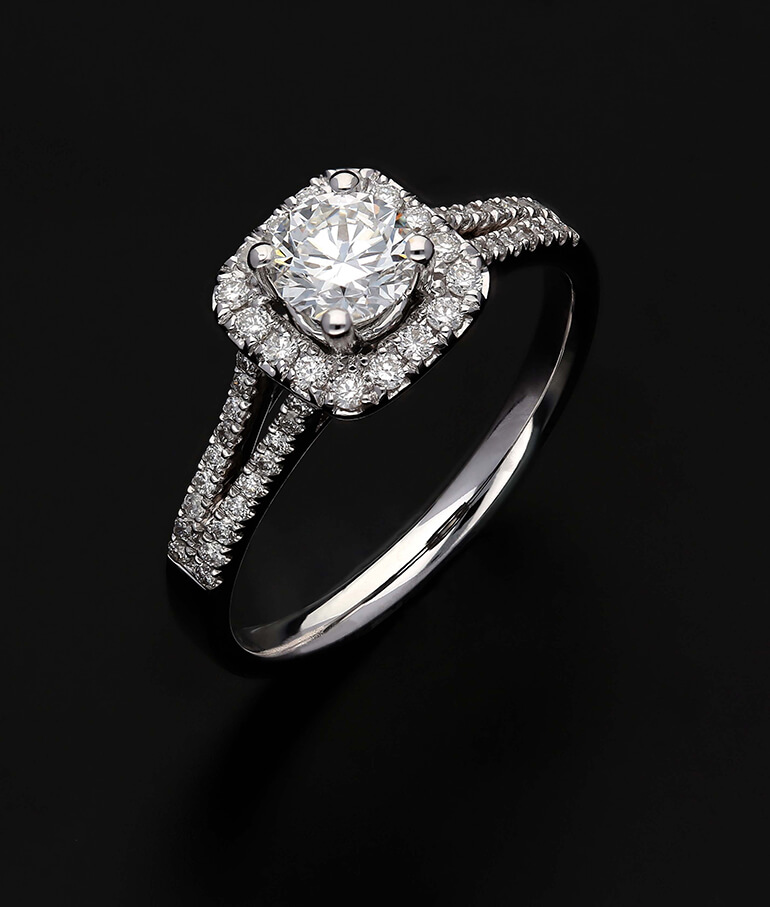HOW TO CHOOSE YOUR DIAMOND?
The « 4 C »
#1
CARAT – CARATAGE
Weight is not the only requirement for assessing a stone, but it is nonetheless essential. The unit of measurement for diamond weight is the carat, which takes its name from the carob seed that was once used to weigh diamonds. A carat corresponds to 0.20 Gr. Different criteria being taken into account in the evaluation of a diamond, two diamonds of the same caratage can have very different values if they have neither the same color, the same purity, nor the same size.
#2
COLOR – COULEUR
The term “color” may seem inappropriate for a diamond as a diamond is all the more exceptional when it is white. There are, however, some exceptions to this rule. Some diamonds of frank and particular colors (fancy colors: yellow, pink, …) are very rare and of a great value. The color of a diamond is classified and evaluated according to a standardized system accepted internationally since the 1950s which goes from D to Z, following the alphabetical order; D meaning exceptional white and Z tinted color.


#3
CUT – SIZE
The cut of a diamond does not refer to its shape or size, but to the way it is cut. For a diamond, the cut is essential; it is the guarantee of its brilliance and shine. Our diamonds are cut according to very strict criteria of proportion to ensure optimal brilliance and a unique shine.
#4
CLARITY – PURITY
Inclusions are natural imperfections in the diamond that, although invisible to the naked eye, distort its quality. The purity of a diamond depends on the number of inclusions, their size and their position in the diamond. The purity grid developed by gemological laboratories (GIA or HRD) is used to classify the stones of: IF (Internally flawless) to I3 (Inclusions visible to the naked eye). A diamond is of IF quality if no imperfections are visible with a 10x magnifying glass.

The ethics of natural diamonds
Ethics and ecology are the two sensitive chords on which the manufacturers of synthetic diamonds play.
Since a few months now, there hasn’t been a trade show or a conference on luxury goods that doesn’t deal with ethics. Synthetic diamonds are of course one of the subjects dealt with, leaving the brands free to promote their jewelry through the media. Unfortunately, representatives of the natural diamond industry are never invited, leaving the field open to synthetic diamond manufacturers.
A STUDY REVEALS THE POSITIVE SOCIAL IMPACT OF THE NATURAL DIAMOND INDUSTRY
The DPA (Diamond Producers Association) entrusted a study from Trucost, a world leader in carbon and environmental data and risk assessment. The study shows that the ethical scale is heavily tilted in favor of natural diamonds: enrichment of local populations, salaries and economic benefits in communities, access to education, water and health.
THE ENVIRONMENT WITHOUT PEOPLE?
Ethics must also take into account social data, not just environmental data.
How many human beings are concerned by an activity that disappears? Is this not as legitimate a question as that of the environment? According to the figures of the Trucost study, the diamond industry provides a living for hundreds of thousands of people around the world. Mining companies alone employ 77,000 people and contractors, mainly in Australia, Botswana, Canada, Lesotho, Namibia, Russia, South Africa and Tanzania. While working conditions are difficult, they are highly regulated. The RJC Code of Practice applies everywhere, often reinforced by the codes of conduct of the mining companies themselves. Workplace safety incidents at DPA member sites, while always dramatic, are below average rates in other industrial sectors. Most of the time, they result from a failure to comply with safety rules.
THE POOR CARBON ASSESSMENT OF LABORATORY DIAMONDS
Greenhouse gas emissions are the most significant impact with an average of 160 kg of CO2 per carat cut in 2016. They remain however 3 times lower than the CO2 emissions produced by the manufacture of a carat of synthetic diamond. Reducing the carbon footprint and investing in renewable energies therefore remain a priority for the DPA. The quarrel between natural and synthetic (laboratory) diamonds is often unjustified. The natural diamond industry has good ethical and ecological advantage to promote and must make it known.

 No products in the cart.
No products in the cart.